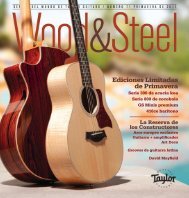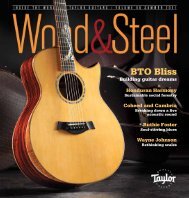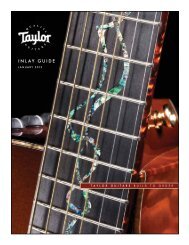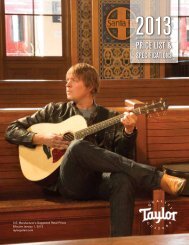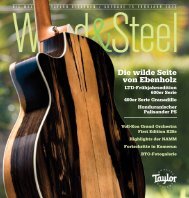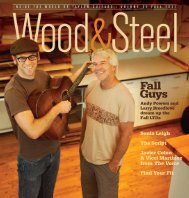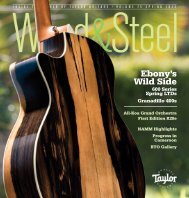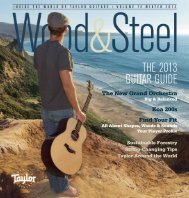Create successful ePaper yourself
Turn your PDF publications into a flip-book with our unique Google optimized e-Paper software.
24 www.taylorguitars.com<br />
clear and balanced across the tonal<br />
spectrum, especially with the arrival of<br />
the Grand Auditorium in the mid-’90s.<br />
<strong>Taylor</strong>s were already known among<br />
studio engineers for being easy to<br />
record with.<br />
By all accounts, there are now close<br />
to 150,000 ES-equipped <strong>Taylor</strong>s out<br />
in the world. Last year alone, 25,000<br />
were built at the factory, according<br />
to <strong>Taylor</strong> electronics department<br />
manager Jeff Houck. By controlling the<br />
manufacturing, installation and servicing<br />
of the pickup systems at the factory,<br />
<strong>Taylor</strong> has been able to maintain a<br />
high level of quality assurance, and if<br />
customers ever do have an issue with<br />
their pickup, <strong>Taylor</strong> can diagnose the<br />
problem and service it efficiently.<br />
“From a manufacturing standpoint<br />
I get to see the nuts and bolts of what<br />
goes into the ES,” says Houck. “All the<br />
ingredients are top shelf — materials,<br />
processes and the people that build<br />
it. Every employee in our department<br />
has worked with the ES program for at<br />
least seven years. That translates to a<br />
group of people who really know what<br />
they are doing.”<br />
The Good Kind of Feedback<br />
One of the most important tasks<br />
associated with introducing the ES was<br />
simply to help live sound engineers<br />
undo the habits they’d developed over<br />
the years, since working with piezobased<br />
pickup systems had given them<br />
a preconceived idea of how to EQ an<br />
amplified acoustic guitar. Once they<br />
understood the simplicity of the ES, it<br />
created a positive situation for everyone<br />
involved, from the player to the front-ofhouse<br />
person to audiences.<br />
“We’ve gotten great reviews on<br />
the acoustic guitar sound,” says David<br />
Morgan, front-of-house engineer<br />
for Cher’s Las Vegas show at the<br />
Colosseum Theater at Caesars Palace.<br />
Morgan’s mixing duties include an<br />
ES-equipped 714ce that guitarist Dave<br />
Barry (k.d. Lang, Janet Jackson) plays<br />
in the show. “It’s a really natural sound.<br />
We’ve had no problems bringing it out<br />
in the mix and it sits very well. I’ve been<br />
really pleased with the ES. It’s easy to<br />
EQ, it’s got nice resonance, and all I do<br />
is add a little Gold Plate [reverb] to it<br />
for a little body and it sounds great.”<br />
On stage, Dave Barry, who also<br />
owns an 812ce, says he loves the live<br />
tone and ease of use.<br />
“One of the things I fell in love with<br />
right away was the natural tone without<br />
having to use a lot of extra outboard<br />
gear,” he says. “The way I have it set<br />
up now is I use the tip, ring, sleeve<br />
[TRS] into the <strong>Taylor</strong> Breakout Box with<br />
the mute switch on it, and that goes<br />
directly into the PA. And we’re using<br />
in-ear monitors, so everything is very<br />
microscopic, more so than a wedge<br />
monitor. [I like] the way the guitar<br />
responds dynamically when I play soft<br />
on it, and when I get after it. It doesn’t<br />
have that — I guess it’s about 500 hz<br />
or so — but there’s a quackiness that<br />
can happen, particularly with piezo or<br />
bridge-style pickups, that this guitar<br />
and this system really sort of butter<br />
over. The other thing I love is that I<br />
hear myself contacting the body of<br />
the guitar. So if I’m tapping on the top<br />
of the instrument while I’m playing,<br />
I can hear all of that, and I like that,<br />
especially in an in-ear scenario. I think<br />
it’s especially good because it gives<br />
a little room to the instrument. So I’ve<br />
really enjoyed it. It’s very simple to use.<br />
You’ve got your volume, you’ve got<br />
your bass, and you’ve got your treble,<br />
and I basically run it pretty flat. It works<br />
great.”<br />
Ohio-based rock band Hawthorne<br />
Heights (916ce, GS8e, K20ce, K4)<br />
usually brings a live sound engineer on<br />
their full electric tours, but they left him<br />
at home for the stripped-down acoustic<br />
tour they did in 2010. With the ES,<br />
they had nothing to worry about.<br />
“Almost every front-of-house<br />
engineer in the clubs said it was the<br />
cleanest signal they’ve ever had,” says<br />
singer/guitarist JT Woodruff. “I always<br />
find that’s pretty impressive — anytime<br />
anyone says you’re giving them a<br />
clean signal means your instrument<br />
is amazing and the pickups are great.<br />
Otherwise, there’s only so much the<br />
front-of-house can do with it.”<br />
Mark Sheehan, the guitarist from the<br />
popular Irish band The Script, which<br />
has opened for the likes of U2 and Paul<br />
McCartney, has played a <strong>Taylor</strong> most<br />
of his career and has come to rely on<br />
the ES.<br />
“The pickup system is amazing<br />
because if you do decide to plug in,<br />
which I have to an awful lot when I’m<br />
doing acoustic shows, you’re gonna<br />
want a system that’s really reliable and,<br />
honestly, is basic,” he says from London<br />
during rehearsals for a 2011 tour in<br />
the U.S. “The old pickup used to have<br />
a notch switch and blend and all this<br />
stuff. I find, if anybody who’s doing<br />
what I have to do, this is the man right<br />
here.”<br />
Putting the ES in<br />
Western Music<br />
Western music singer-songwriter<br />
Jon Messenger has seen a tremendous<br />
influx of <strong>Taylor</strong>s among the Western<br />
music community in recent years. He<br />
attributes this to both the pure acoustic<br />
playing experience and the ease of use<br />
of the ES. He was already a longtime<br />
<strong>Taylor</strong> owner himself — he has a 1984<br />
Brazilian rosewood 710 — and a<br />
veteran of a variety of different acoustic<br />
amplification scenarios from over the<br />
years. When he used to perform with a<br />
bluegrass band he would play the 710<br />
into a microphone, and had to contend<br />
with feedback issues. Eventually he<br />
had another brand of pickup installed,<br />
which he could dial in because he also<br />
has experience running sound for live<br />
performances. After the Expression<br />
System’s debut, he had a chance to<br />
plug in an ES-equipped 614ce at a<br />
music store in Arizona.<br />
“Right away you could hear a quality<br />
best described as transparency,” he<br />
says. “The claim was that you were<br />
going to accurately be able to translate<br />
not only tone but the feel — like when<br />
you sit alone in a room playing your<br />
guitar and bend a note or you squeeze<br />
the wood just so, and you get that<br />
tonal quality coming out of a guitar<br />
that you can capture with a really good<br />
microphone. The claim was true.”<br />
That 614ce is currently Messenger’s<br />
main guitar, and he says it’s saved him<br />
on more than a few occasions, unlike<br />
other acts that don’t have the ES.<br />
“You know very well that when you<br />
go to play out, you’re completely at<br />
the mercy of the sound guy,” he says.<br />
“Sometimes we’ll get a sound guy from<br />
another genre who doesn’t have any<br />
conception of what acoustic guitars<br />
are supposed to sound like. We always<br />
have good sets when other people<br />
have all kinds of trouble. Whether I’m<br />
playing by myself or in a trio, all I need<br />
to do is take the <strong>Taylor</strong> cable, plug<br />
it into a mic [XLR] cord, and run it<br />
through the PA board. And for playing<br />
rhythm, I set my volume knob at about<br />
9 o’clock. The soundman can’t screw<br />
you up. All you have to do is have it flat<br />
and on.”<br />
For a tight-knit musical community<br />
like the Western Music Association, the<br />
positive word-of-mouth about the ES<br />
among musicians has been substantial.<br />
“I got people to buy <strong>Taylor</strong>s just<br />
based on hearing what the guitar<br />
sounded like sitting around picking,<br />
and that was even before the ES,” he<br />
says. “Once people started showing<br />
up with the ES, when people heard<br />
what it sounds like and discovered<br />
the ease of operation — how many<br />
headaches in your life just disappeared<br />
in live performance — every time I<br />
turned around, somebody else has<br />
got a <strong>Taylor</strong> guitar in their hands who<br />
used to play something different. The<br />
things sell themselves. The group effort<br />
that you guys have put into this has<br />
really created a wonderful world in the<br />
modern era for making music. And that<br />
works across the entire spectrum of<br />
genres.”<br />
The ES at a Glance<br />
The Expression System was designed to blend seamlessly into the<br />
anatomy of the guitar. The 2011 iteration features two magnetic pickups —<br />
a body sensor mounted to the underside of the soundboard to capture<br />
the nuances of the top movement, and a string sensor embedded<br />
beneath the fretboard extension (near the neck pocket) to register string<br />
and neck vibration. A studio-grade preamp boosts the signal cleanly<br />
without adding noise. Three soft-touch roller knobs (Volume, Treble, Bass)<br />
make it easy to shape your tone, and each features a center detent,<br />
which comes in handy in low-light conditions. There’s also a switch on<br />
the preamp board that allows you to turn off the body sensor, which<br />
gives you flexibility in different performance situations. With a fresh 9-volt<br />
battery, you can expect about 40 hours of amplification. One additional<br />
safety feature is a fused string ground, which will protect you from being<br />
shocked as a result of a faulty electrical ground.<br />
Sound Advice<br />
The Expression System features a different design from many other<br />
pickup systems. Here are a few tips that will help the sound engineer<br />
help you sound good at a gig.<br />
Plug in: Most other pickup systems<br />
produce an “unbalanced” signal,<br />
meaning that the amplified tone can<br />
only travel a short distance without<br />
tone loss. They are also more subject<br />
to noise, distortion and ground-loop<br />
issues. To minimize those issues, the<br />
signal is usually run through a direct<br />
input (DI) box, which converts the unbalanced signal to balanced. The ES<br />
was designed to have a balanced signal, so no DI box is necessary. Just<br />
use a TRS to XLR cable straight from the guitar to the snake or mixer.<br />
Tune up: To maintain the balanced<br />
signal from guitar to amp/PA and<br />
use a digital tuner, we recommend<br />
our Balanced Breakout Box. Your<br />
signal passes through the box with<br />
XLR in and out jacks. There is a ¼”<br />
jack that you plug your tuner into,<br />
and your signal is tapped and fed to<br />
your tuner. There is a mute switch<br />
on the Balanced Breakout Box that<br />
silences the XLR output for silent tuning.<br />
Turn up: Many sound engineers<br />
have a preconceived<br />
idea of how to EQ an acoustic<br />
guitar based on their experience<br />
with piezo pickups in<br />
acoustics. Their “go-to” acoustic<br />
setting can have some<br />
pretty radical EQ adjustments.<br />
With the ES, you want to<br />
start with the ES controls at<br />
their center detents and have<br />
the sound man start with the<br />
channel adjusted flat. If the PA is EQ’d for the room, you’ll have a great<br />
sound with the settings flat. He can then fine-tune to taste.




